Determining the true cost of producing eggs on a homestead involves more than just tallying feed and care expenses—it’s about appreciating the effort behind each dozen eggs. The costs can vary widely, influenced by factors like feed and chicken breeds. Understanding these elements helps reveal the true value of each egg, empowering you to make more informed decisions for your homestead.
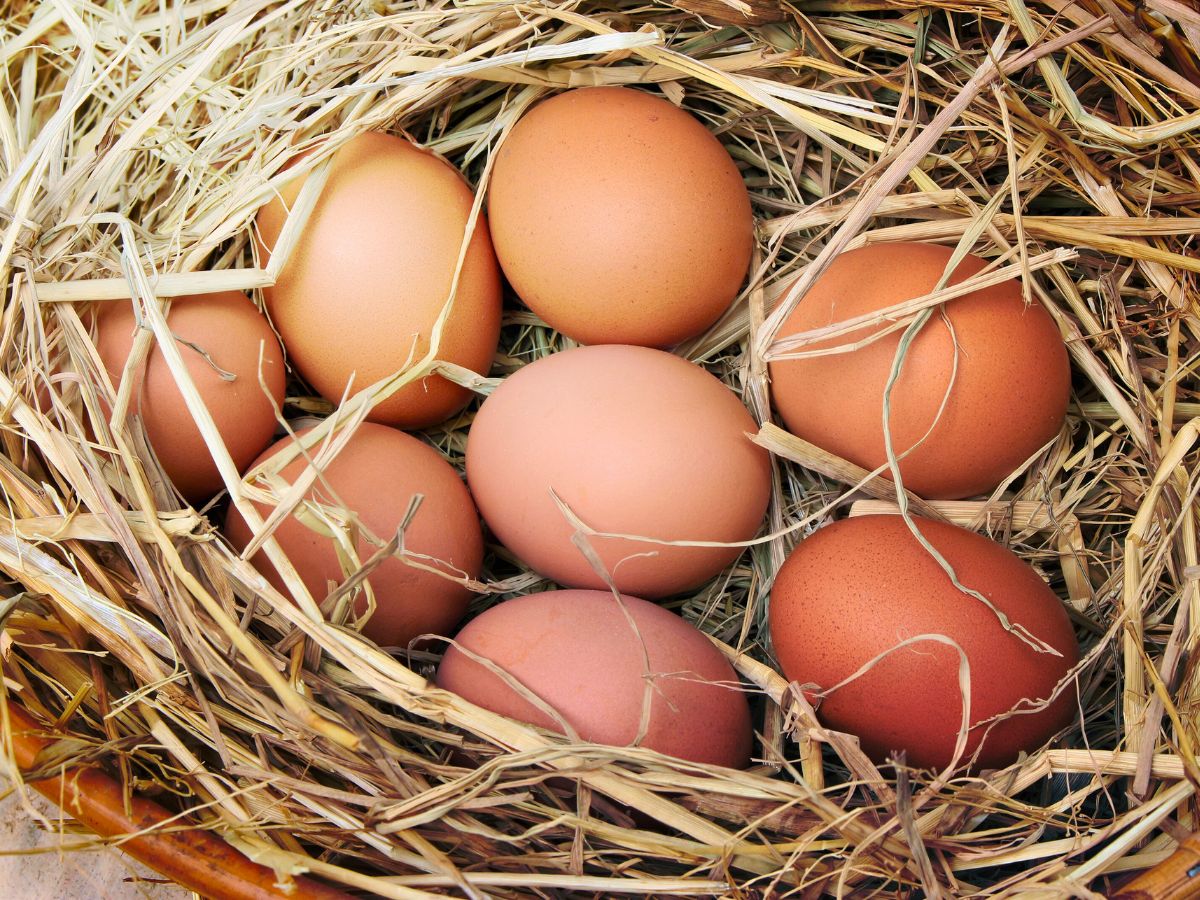
In This Post
Feed Requirements in the Cost of Egg Production
Chickens need a consistent and nutritious diet—carbohydrates, proteins, fats, minerals, and vitamins—which are essential for their health and productivity. An average laying hen consumes about half a cup of food daily, which adds up to about 90 pounds of feed per year for each hen. For a homesteader with ten hens, this means buying approximately 19 fifty-pound bags annually.
Depending on your local feed prices and the type of feed you purchase, this can cost anywhere from $190 to $570 annually. The breed of chicken also impacts feed efficiency and egg production; for instance, breeds like Silkies eat less but also lay fewer and smaller eggs than more prolific layers like the Black Australorp.
You can learn all about feeding chickens in our companion article.
Watch the Video For This Post
Strategies to Lower Feed Costs
While feed accounts for a significant part of the cost of raising chickens, adopting free-ranging practices can help reduce these expenses. Allowing chickens to roam and forage for some or most of their food can decrease the amount of commercial feed they consume. This not only lowers your feed bill but also provides the chickens with a varied diet, which can lead to healthier birds and potentially better-quality eggs.
Not everyone can free range their chickens due to space, local regulations, or predator concerns. However, if you can, it can be a highly effective way to cut costs and improve the overall well-being of your flock.
The extent of savings from free ranging also depends on your land’s available resources and how effectively your breed of chickens can forage. It’s also worth noting that free-ranging isn’t without risks, as it exposes chickens to potential predators and environmental hazards. But with the right knowledge and preparation, you can mitigate these risks and ensure the safety of your flock. You can read about the pros and cons and learn how to free range your chickens in our companion article.
Many homesteaders use methods like fermenting feed to reduce costs and increase sustainability. Fermenting feed enhances its nutritional value and digestibility. Our companion article explains how to ferment chicken feed.
Growing mealworms or black soldier flies is an easy and relatively inexpensive way to provide protein for your chickens. There are some guidelines you must be aware of. Overfeeding hens with high-protein worms, particularly at night, can lead to issues with egg production. You can learn all about how to grow mealworms in our companion article.
If your chickens are confined to a yard, you can supplement their diet, which can significantly reduce feed costs and improve their overall health. One effective method is to provide garden scraps, like kale, turnip greens, radish tops, watermelons, winter squash, and more. These are full of essential vitamins and minerals.
Growing microgreens is another easy and beneficial option; they’re simple to cultivate and packed with nutrients that chickens love. You can also grow forage crops directly in the yard, giving your chickens fresh greens to peck at. Placing old boards or logs in the yard attracts bugs and insects, which the chickens eagerly consume. Adding old hay bales not only provides a great source of bugs but also keeps the chickens entertained as they scratch through them.
Additionally, compost piles are a fantastic resource, as chickens will scratch through them for worms and other organic matter, aiding in composting while getting extra nutrition. These practices not only lower feed expenses but also enrich your chickens’ diet, leading to healthier and more productive birds. There are a few things you should not feed your chickens, and you can listen to our podcast about them for more information.
Symbiotic Relationships on the Farm
Integrating chickens with other farm animals on a homestead can be beneficial. Chickens can follow behind pigs and cows, foraging in their manure for undigested grains and larvae. This symbiotic relationship not only provides additional nutrition for the chickens but also helps reduce feed costs and improve soil quality.
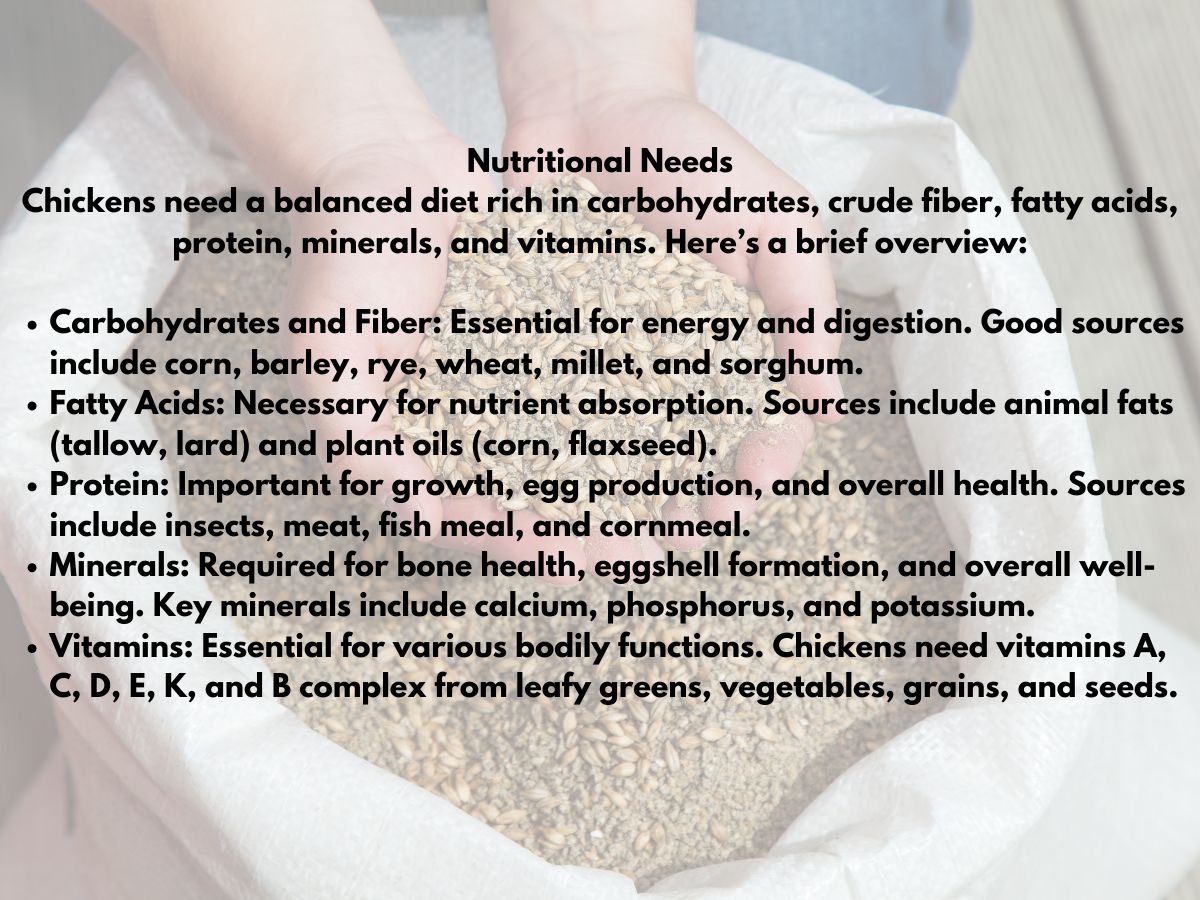
Growing Your Own Feed
Did you know some people never buy chicken feed? Our companion article shares how it’s done, but here is some information to consider.
Growing your own chicken feed can save money and ensure your flock gets the best nutrition. You don’t need a lot of space to get started, just a small area in your backyard or homestead can help provide some feed to a small flock.
While there might be some initial costs for seeds and fencing, the savings over time can be significant compared to buying commercial feed. Plus, there’s something deeply satisfying about providing your chickens with food you’ve grown yourself.
Oatmeal Controversy:
Oatmeal is pretty controversial. Oats contain beta-glucan, which chickens and other animals struggle to digest efficiently. Some research indicates that beta-glucan can lead to the formation of a thick gel that lines the birds’ intestines, preventing nutrient absorption. We choose not to eat it ourselves or feed it to our chickens or other animals, but you can decide what’s right for you based on your own research.
Nutritional Requirements in Cost of Egg Production
For carbohydrates and fiber, which are essential for energy and digestion, consider sources like corn, barley, rye, and wheat. For fatty acids needed for nutrient absorption, fats like tallow, lard, and plant oils are beneficial. Proteins for growth and egg production can come from insects, meat, fish meal, and cornmeal. Minerals such as calcium, phosphorus, and potassium are crucial for bone health and eggshell formation. Vitamins A, C, D, E, K, and B complex can be obtained from leafy greens, vegetables, and seeds.
Growing Specifics:
To grow feed for 10 chickens for a year, you’ll need:
- 450 feet of corn rows for 300 pounds of corn.
- 3000 square feet for 270 pounds of wheat.
- 2000 square feet for 180 pounds of peas.
- 90 pounds of fish meal (sourced from fishing or other meats).
- 18 to 20 pounds of fresh greens can be grown in a 6×3 foot garden bed.
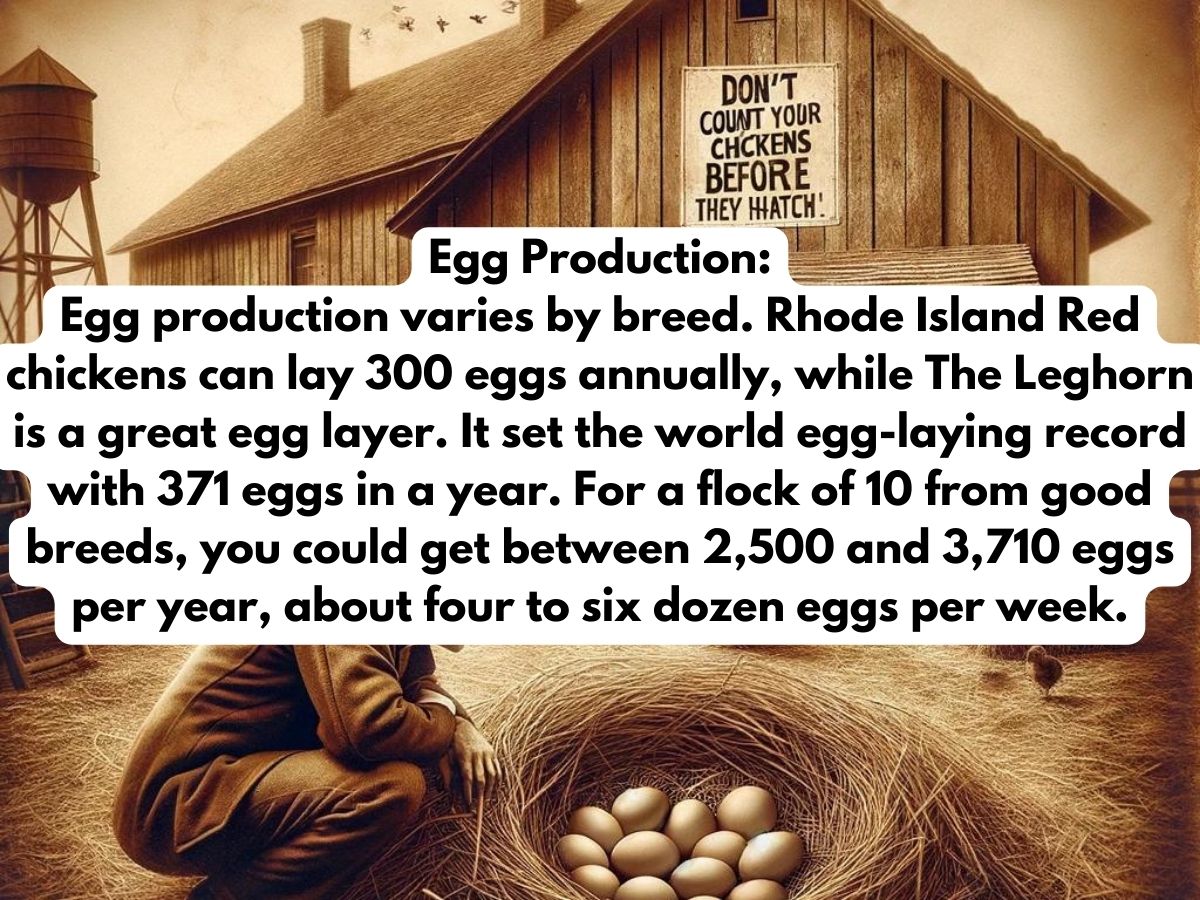
Other Factors Affecting the Cost of Egg Production
Egg production varies significantly depending on the breed of chicken, making breed selection the number one consideration for egg laying. Some breeds, like Polish or Silkies, may lay around 100 eggs yearly, while others, such as Black Australorps, Speckled Sussex, or Rhode Island Reds, can produce 300 to 350 eggs annually.
With ten hens of a lower-laying breed, you might collect around 1,300 eggs a year, whereas a flock of high-producing breeds could yield over 3,200 eggs a year. Understanding these differences is crucial for estimating your egg yield and setting realistic expectations as to the cost of egg production.
Different breeds are suited for different climates and have different space requirements and temperaments. Some do better in colder climates than others, and some do better in warmer climates. Space is also a crucial factor; how much does the breed you want to raise need? How much space do you have available? It will save you money and time if you Do your research before deciding on a breed.
We wrote a book, The Farmer’s Lamp Guide to Successful Chicken Keeping, that rates the best breeds and includes detailed information about them. You’ll find knowledge and information about keeping chickens naturally throughout their lives, including breed selection, housing, health, feeding, egg and meat production, and more! You can get it in our poultry bundle using the link below.
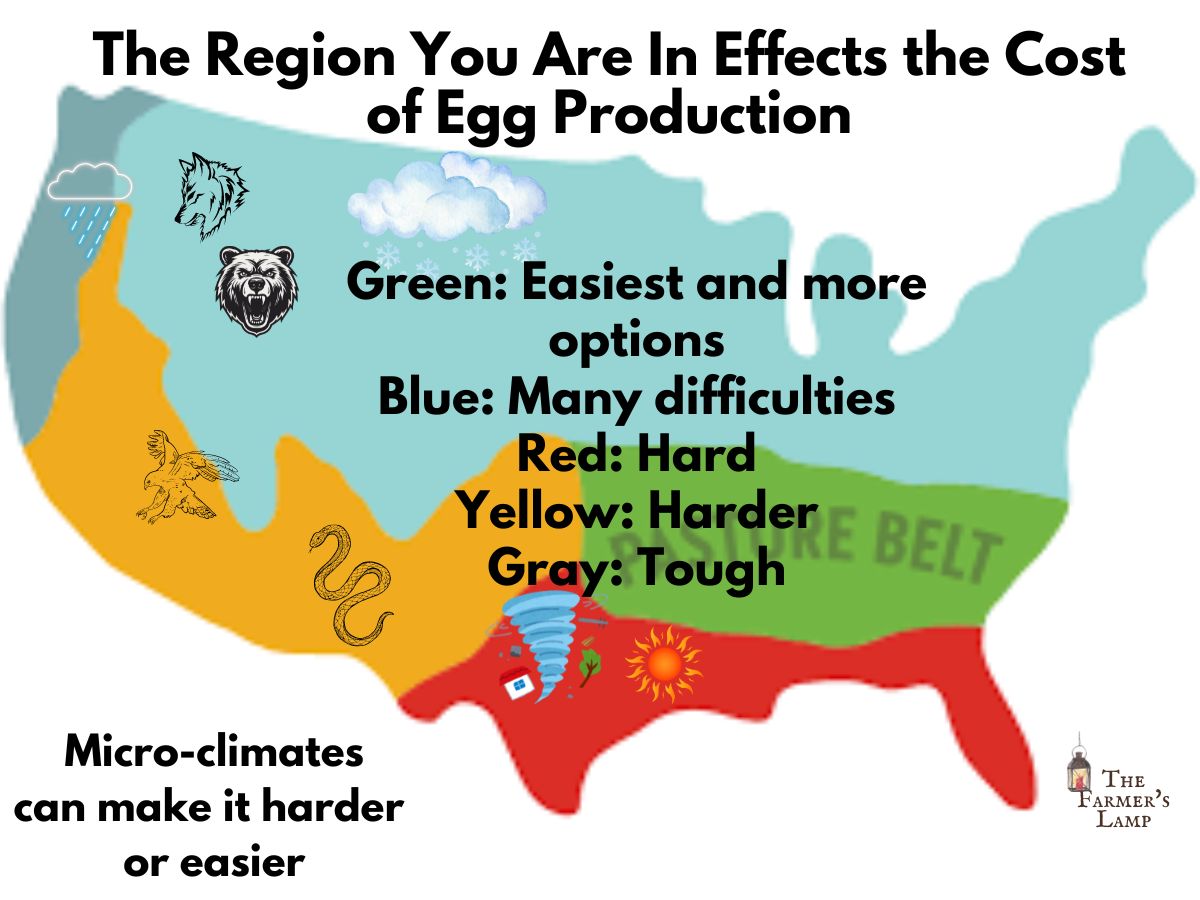
Geographical and Environmental Factors
Raising chickens can be influenced by geographical factors and environmental conditions. Different regions in the U.S. present unique challenges. For instance, with its intense heat and severe storms, the Deep South requires careful breed selection, shade, and fresh water. Tornadoes and thunderstorms also necessitate robust shelter for the chickens.
In contrast, the Pasture Belt, known for its moderate weather, offers ideal conditions for raising chickens with minimal cost and effort. This region’s mild winters and balanced temperatures make it easier for chickens to thrive with almost zero cost in raising them.
Areas with harsh winters, heavy snowfall, or unusual predators like bears, wolves, and porcupines demand more resilient breeds and additional protective measures to maintain a healthy flock. These regions require chicken breeds that can withstand severe cold and have shelter that protects them from the elements and predators.
Additionally, microclimates within larger regions can affect chicken raising. Understanding these microclimates can help optimize your flock’s productivity. Specific local conditions may allow for different agricultural practices, such as growing certain crops that can supplement the chickens’ diet. Recognizing and leveraging these microclimates can significantly enhance the sustainability and efficiency of raising chickens in various regions.
Seasonal Variations
Egg production is influenced by the seasons. As daylight hours shorten in fall and winter, you might notice a drop in your hens’ egg-laying. While the longer days in spring and summer boost production. Some breeds, like Rhode Island Reds and Australorps, continue to lay eggs even in winter, though it may be at a reduced rate.
I have to say our Australorps and Speckled Sussex hens barely slow down. Selecting hardy breeds that can tolerate seasonal changes can help maintain a consistent egg supply throughout the year.
Age of the Hens
The age of your chickens plays a crucial role in egg production. Young hens, especially those in their first two years, are at their peak laying capacity. As hens age, their productivity gradually declines. If you want to maintain a consistent egg supply, plan on introducing new hens to your flock every few years.
Allowing broody hens to hatch their own eggs eliminates the cost of adding new birds to your flock. However, if you decide to purchase a different breed, order more of your current breeds, or buy eggs for incubation, these expenses will impact the overall cost of egg production, so be sure to account for them.
This rotation helps balance out the natural decrease in egg production as your birds age. Our companion article will teach you how to introduce new hens to an established flock.
Health and Wellbeing
Happy, healthy flocks are productive. The quality of feed and clean water directly impacts their health and egg-laying ability. The breed you choose is also important, as some breeds can thrive in confinement while others are better suited to free-ranging.
Housing and environment also play a significant role in their overall health. Stressful environments, overcrowding, and poor sanitation can all result in lower egg yields.
To keep your chickens happy and healthy, ensure they have enough space, clean living conditions, and regular routines. Additionally, consider the layout of your coop and run: providing sufficient nesting boxes and safe, comfortable roosting spots can encourage more consistent laying. Our companion post will help you with everything a good coop needs.
Incorporating natural methods to boost their immune systems and regularly managing parasites greatly helps maintain the health of your flock. These small things help cut the cost of egg production by keeping your flock flourishing. You can read about how we do these things in our companion article on common poultry diseases and how to help prevent them. Granny always said, “Happy, healthy chickens lay happy, healthy eggs.”
Additionally, think about how much time you can dedicate to your chickens. Some breeds are more independent and require less hands-on care, while others might need more attention and social interaction. For example, Silkies and Polish chickens often enjoy human interaction and can make great pets in addition to being egg layers.
Each breed has strengths and weaknesses, so select the ones that best match your homesteading goals. Whether you prioritize egg production, meat, or even temperament, choosing the right breeds will help ensure your homestead flock is productive and well-suited to your environment.
Dual Purpose Chickens
Dual-purpose chickens that provide meat and eggs are ideal for a self-sufficient lifestyle. On our homestead, we prioritize raising heritage breeds. These chickens are resilient, adaptable to various conditions, and offer a steady supply of eggs and meat. By choosing heritage breeds, we support genetic diversity, maintain traditional farming practices, and keep our homestead cost-effective.
Raising dual-purpose chickens helps you get the most out of your flock. These chickens provide both eggs and meat, so you don’t need separate breeds for each. This efficient use of resources makes your homesteading more economical and rewarding, lowering the overall cost of egg production and adding to your food supply. You can learn more about dual purpose breeds in our companion article.
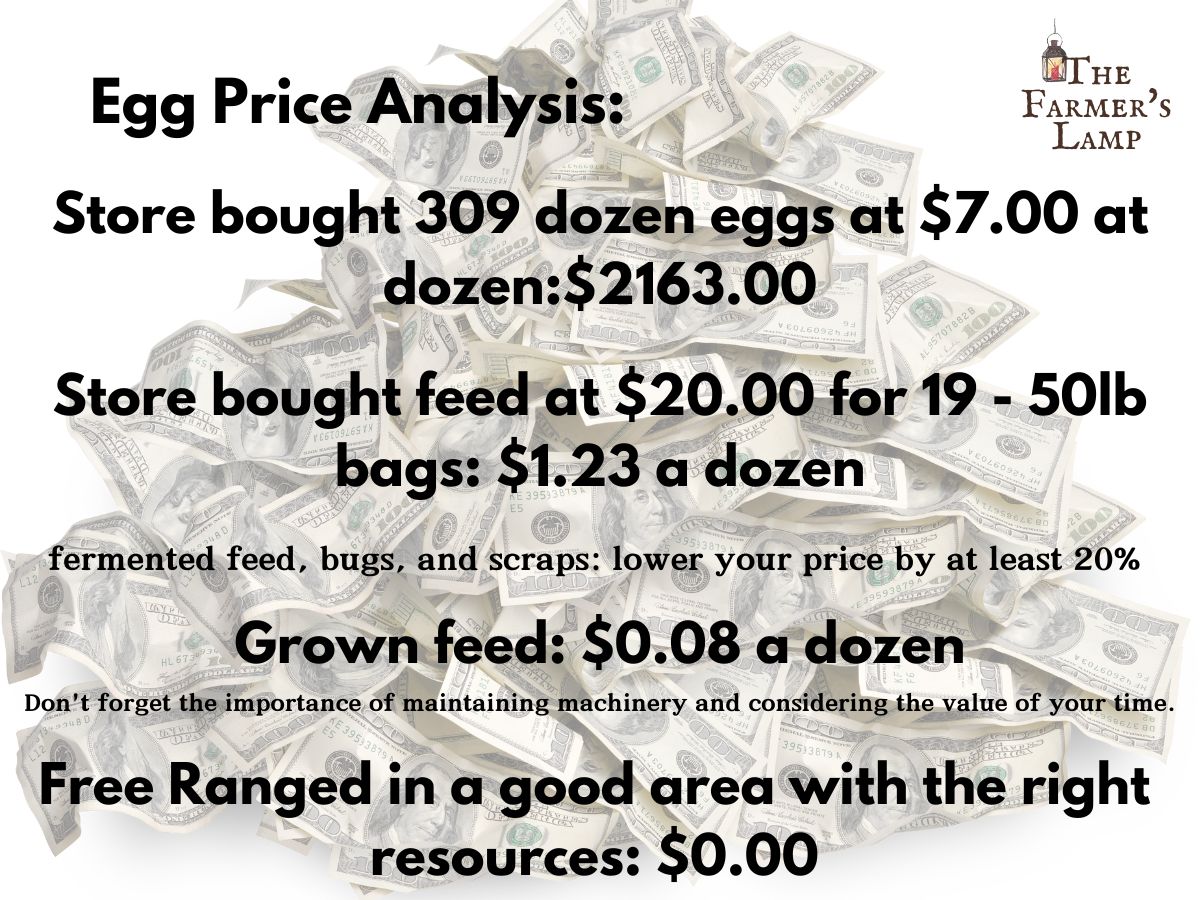
Breakdown of the Cost of Egg Production Based on These Factors
Understanding the cost of producing eggs is crucial for any homesteader. Here’s a detailed analysis of the costs involved with different feeding methods and ways we’ve discussed to lower the cost of egg production. For all of our considerations, we are using a flock of 10 hens of a good laying breed as our working example.
Remember, these costs are variable according to what you can do to decrease your costs of feed, housing, and other factors, but this will give you a good idea of what to expect.
- Compared to Store Bought Eggs:
Store-bought, pasture-raised eggs can cost around $7.00 per dozen. For 309 dozen eggs (what a good breed will lay in a year), this totals approximately $2,163.00 annually. - Birds Raised on Store Bought Feed at $20.00 a bag for 19 fifty-pound bags:
The cost for ten hens is approximately $380 per year. This results in about $1.23 per dozen eggs.- Supplementing store bought feed with fermented feed, bugs, kitchen scraps, and other things we’ve discussed, like garden produce, hay, etc., can reduce your feed costs by at least 20%. This lowers the price per dozen eggs, making it even more cost-effective.
- Birds Fed Home Grown Feed:
Growing your chicken feed can significantly cut costs. Even with the initial cost of seeds at around $40, you will save lots of money the first year. If you save seeds for replanting in subsequent years, you will avoid the annual cost of purchasing seeds, increasing the savings. With homegrown feed, the cost drops to about $0.08 per dozen eggs. - Free Range in a Good Area with Resources:
In ideal conditions, where chickens can free range and forage for their food and where there are plenty of resources on the land, the cost can drop to $0.00 per dozen eggs!
We aren’t there yet, but we hope to be. We’re happy with our current cost of egg production being around $0.04 a dozen. We’ve worked hard to achieve this by growing garden produce and using all the tips we’ve shared with you, except growing all of our chicken feed. We still purchase cracked corn and feed our birds like my great-grandmother and grandmother did. Using the white bucket they are trained to, I give them a handful every morning and every evening. This routine not only keeps them tame and used to me but also helps gather them into the yard in the evening so I can check on them before they go to bed.
Don’t forget the importance of maintaining machinery and considering the value of your time. Proper maintenance of equipment, like coops and feeders, and the time invested in caring for your flock are crucial factors in your overall egg production costs.
Understanding the financial aspect of egg production can help you decide how best to manage your flock. Start by keeping track of your expenditures on feed, bedding, coop maintenance, and any other incurred expenses. A simple ledger will help you balance these costs against your egg production.
Keeping detailed records not only shows you where you stand financially but also helps you make smart choices for the future. By managing and analyzing these expenses carefully, you can keep your homestead’s egg production sustainable and economically sound.
If you’re a member of TFL Community, check out the Members Only Library for the free download of Profitable Backyard Chickens. If you’re not a member, you can use the form below to join us and get the download.
Wrap UP
Understanding the intricacies of what it really costs to produce eggs on a homestead empowers us to make informed decisions about our practices. Every detail counts, from evaluating feed requirements and costs, considering geographical factors, and supplementing feed within the chicken yard to choosing the right breeds and understanding the cost breakdown.
Whether you’re adjusting feed methods, choosing different breeds, or even starting to grow your own feed, every step you take brings you closer to a more sustainable and rewarding homesteading life. Don’t forget the importance of maintaining machinery and considering the value of your time in your overall cost calculations.
We’d love for you to share your experiences or tips on reducing costs and increasing efficiency in your flock’s egg laying. Let’s continue to learn from each other and improve our homesteading skills together!
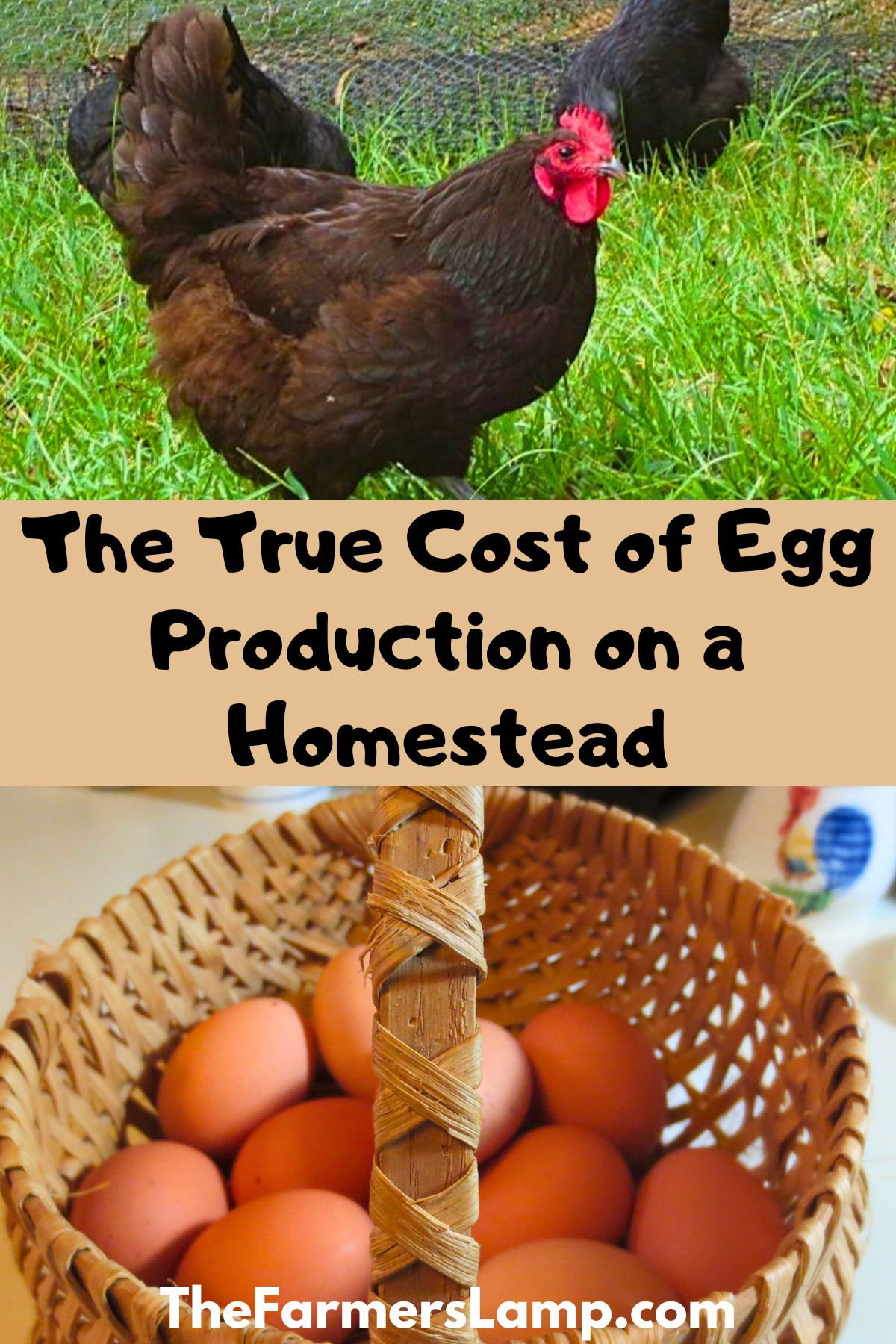

Leave a Reply